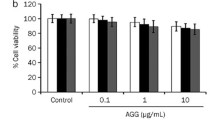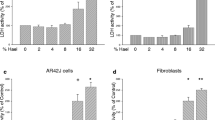Abstract
Hepatocellular carcinoma (HCC) is the leading cause of cancer related deaths in the world, with increasing incidence in many developed countries. Epidemiological data suggest that consumption of soy products may be associated with a decreased risk of cancer. We investigate the effects of genistein on cell proliferation, apoptosis and caspase-3 in DEN induced (200 mg/kg body weight; by single intraperitoneal injection) and Phenobarbital promoted (0.05% through drinking water for 14 successive weeks) cancer-bearing rats. Immunohistochemistry was employed to detect cell proliferating markers proliferating cell nuclear antigen (PCNA), DNA fragmentation was determined by agarose gel electrophoresis and terminal deoxynucleatide transferase dUTP nick labeling (TUNEL) staining and caspase by enzyme-linked immunosorbent assay. We found inhibition of cell proliferation, induction of apoptosis and activation of caspase-3 in genistein treated animals. From these results, we conclude that genistein inhibit cell proliferation, induced apoptosis. This activation of caspsase-3 in genistein treated liver cancer bearing animals correlated well with its apoptosis inducing effect.
Similar content being viewed by others
References
Quaglia A, Bhattacharya S, Dhillon AP (2001) Limitation of the histopathological diagnosis and prognostic assessment of hepatocellular carcinoma. Histopathology 38: 167–174
Thirunavukkarasu C, Prince Vijeya SJ, Selvendiran K, Sakthisekaran D (2002) Chemopreventive efficacy of selenium against N-nitrosodiethylamine-induced hepatoma in albino rats. Cell Biochem Funct 19: 265–271
Pitot HC (1998) Hepatocyte death in hepatocarcinogenesis. Hepatology 28: 1–5
Stinchcome S, Buchmann A, Bock KW (1995) Inhibition of apoptosis during 2,3,7,8-tetrachlorodibenzo-p-dioxin-mediated tumour promotion in rat liver. Carcinogenesis 5: 453–458
Messina MJ, Persky V, Setchell KD, Barnes S (1994) Soy intake and cancer risk: a review of the in vitro and in vivo data. Nutr Cancer 21: 113–131
Kennedy AR (1995) The evidence for soybean products as cancer preventive agents. J Nutr 125(Suppl 3): 733S–743S
Yoon HS, Moon SC, Kim ND, Park BS, Jeong MH (2000) Genistein induces apoptosis of RPE-J cells by opening mitochondrial PTP. Biochem Biophys Res Commun 276: 151–156
Constantinou A, Hubeman E (1995) Genistein as an inducer of tumor cell differentiation: possible mechanisms of action. Proc Soc Exp Biol Med 208: 109–115
Salti GI, Grewal S, Mehta RR, Das Gupta TK, Boddie AW Jr, Constantinou AI (2000) Genistein induces apoptosis and topoisomerase II-mediated DNA breakage in colon cancer cells. Eur J Cancer 36: 796–802
Yoshiji H, Nakae D, Kinugasa T, Matsuzaki M, Denda A, Suiji T (1991) Inhibitory effect of the iron deficiency on the induction of putative preneoplastic foci rat liver initiated with diethylnitrosamine and promoted by phenobarbital. Br J Cancer 64: 839–842
Lu S, Zhan AH, Huang XX, Ren YJ (2002) Expression and significance of proliferating cell nuclear antigen in resistance of lithium carbonate to aflatoxin B1 induced hepatocarcinogenesis in rats. Alibian Jibian Tubian 14: 84–86
Zhang XL, Shi JQ, Bian XW (2001) Quantitative study on morphologic features and proliferative activity during DEN induced hepatocarcinogenesis in rats. Disan Junyl Daxue Xuebau 23: 304–307
Kui Y, Lin C, Wu W (1998) Relationship between several important modulators of cell cycle G1-S check point and tumor. Guowai Yixue Fenzi Shengwuxue Fence 20: 10–13
Liu LX, Jiang HC, Zhu AL, Wang XQ, Zhu J (2001) Cell cycle and growth regulators gene expression in liver cancer tissues and adjacent normal tissues. Zhonghua Shiyan WaikeXue Zazhi 18: 123–126
Andrikoula M, Tsatsoulis A (2001) The role of Fas-mediated apoptosis in thyroid disease. Eur J Endocrinol 144: 561–568
Wang LD, Zhou Q, Wei JP, Yang WC, Zhou X, Wang LX, Zou JX, Gao SS, Li YX, Yang CS (1998) Apoptosis and its relationship with cell proliferation, p53, Waf1p21, bcl-2 and c-myc in eosophageal carcinogenesis studied with a high-risk population in northern China. World J Gastroentero 4: 287–293
Kanzler S, Galle PR (2000) Apoptosis and the liver. Semin Cancer Biol 10: 173–184
Park YN, Chae KJ, Kim YB, Park C, Theise N (2001) Apoptosis and proliferation in hepatocarcinogenesis related to cirrhosis. Cancer 92: 2733–2738
Chiarugi V, Magnelli L, Cinelli M, Basi G (1994) Apoptosis and the cell cycle. Cell Mol Biol Res 40(7–8): 603–612
Huang P, Ballal K, Plunkett W (1997) Biochemical characterization of the protein activity responsible or high molecular weight DNA fragmentation during rug induce apoptosis. Cancer Res 57(16): 3407–3414
Lazebnik YA, Kaufmann SH, Desnoyers S (1994) Cleavage of poly (ADP-ribose) polymerase by a proteinase with properties like ICE. Nature 371: 346–347
Slee EA, Harte MT, Kluck RM, Wolf BB, Casiano CA, Newmeyer DD, Wang HG, Reed JC, Nicholson DW, Alnemri ES, Green DR, Martin SJ (1999) Ordering the cytochrome c-initiated caspase cascade: hierarchical activation of caspase-2, -3, -6, -7, -8, and -10 in a caspase-9-dependent manner. J cell Biol 144: 281–292
You KR, Shin MN, Park RK, Lee SO, Kim DG (2001) Activation of caspase-8 during N-(4-hydroxyphenyl) retinamide-induced apoptosis in Fas-defective hepatoma cells. Hepatology 34: 1119–1127
Lin SY, Chang YT, Liu JD, Yu CH, Ho YS, Lee YH, Lee WS (2001) Molecular mechanism of apoptosis induced by magnolol in colon and liver cancer cells. Mol Carcin 32: 73–83
Tewari M, Quan LT, O’Rourke K, Desnoyers S, Zeng Z, Beidler DR, Poirier GG, Salvesen GS, Dixit VM (1995) Yama/CPP32 beta, a mammalian homolog of CED-3, is a CrmA-inhibitable protease that cleaves the death substrate poly(ADP-ribose) polymerase. Cell 81(5): 801–809
Darmon AJ, Nicholson DW, Bleackley RC (1995) Activation of the apoptotic protease CPP32 by cytotoxic T-cell-derived granzyme B. Nature 377(6548): 446–448
Faleiro L, Kobayashi R, Fearnhead H, Lazebnik Y (1997) Multiple species of CPP32 and Mch2 are the major active caspases present in apoptotic cells. EMBOJ 16: 2271–2281
Kumar S (1997) The apoptotic cysteine protease CPP32. Int J Biochem Cell Biol 29: 393–396
Porter AG, Janicke RU (1999) Emerging roles of caspase-3 in apoptosis. Cell Death Differ 6: 99–104
Jones RA, Johnson VL, Buck JN, Dobrota M, Hinton RH, Chow SC, Kass GN (1998) Fas-mediated apoptosis in mouse hepatocytes involves the processing and activation of caspases. Hepatology 27: 1632–1642
Bajt ML, Lawson JA, Vonderfecht SL, Gujral JS, Jaeschke H (2000) Rotection against Fas receptor-mediated apoptosis in hepatocytes and nonparenchymal cells by a caspase-8 inhibitor in vivo: evidence for a postmitochondrial processing of caspase-8. Toxicol Sci 58: 109–117
Chen Q, Peng W, Qi S, Xu A (2002) Apoptosis of human highly metastatic lung cancer cell line 95-D induced by acutiaporberine, a novel bisalkaloid derived from Thalictrum acutifolium. Planta Med 68(6): 550–553
Alberto Monasterio Maria C, Urdaci Irina V (2004) flavonoids induce apoptosis in human leukemia U937 cells through caspase and caspase-calpain dependent pathway. Nutrition Cancer 50(1): 90–100
Acknowledgment
One of the authors, Dechen Chodon, acknowledges the Indian Council of Medical Research (ICMR), New Delhi, India for the financial assistance given in the form of Senior Research Fellowship.
Author information
Authors and Affiliations
Corresponding author
Rights and permissions
About this article
Cite this article
Chodon, D., Banu, S.M., Padmavathi, R. et al. Inhibition of cell proliferation and induction of apoptosis by genistein in experimental hepatocellular carcinoma. Mol Cell Biochem 297, 73–80 (2007). https://doi.org/10.1007/s11010-006-9324-2
Received:
Accepted:
Published:
Issue Date:
DOI: https://doi.org/10.1007/s11010-006-9324-2




